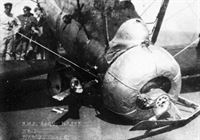
Описание
Страна : Великобритания
Год : 1918
Двухместный разведывательный самолет корабельного базирования
Parnall. Самолеты
Во время Первой мировой войны деревообрабатывающая компания "Parnall & Sons" построила по заказу других компаний несколько самолетов, включая модели Avro 504 и Fairey Hamble Baby. Ее первые собственные разработки, истребитель дирижаблей Parnall Scout и однопоплавковый самолет-амфибия Puffin, были неудачными.
В 1917 году в компанию на работу в качестве главного конструктора поступил Гарольд Болас, после чего в следующем году был заключен контракт R-1820-76A на постройку 300 двухместных разведывательных бипланов Panther. Но вскоре было заключено перемирие в войне, и Министерство авиации уменьшило заказ до 150 машин. К тому времени У.Т. Авери приобрел у Д. Парналла компанию "Parnall & Sons" и отказался от взятых ею обязательств. После этого контракт R-1820-76A был передан компании "British & Colonial Aeroplane Со.", которая и построила все 150 самолетов в 1919-1920 годах. Компания "Parnall" выпустила только шесть прототипов. Panther не был успешным самолетом, но он стал одним из первых британских палубных самолетов. Два самолета были поставлены в 1920 году в США, а 12 машин в 1921-1922 годах - в Японию. Последние Panther авиации британского флота были списаны в 1926 году, им на смену пришли самолеты Fairey IIID. После потери контракта на выпуск Panther владелец У.Т. Авери ликвидировал компанию "Parnall & Sons" и вышел из авиастроительного бизнеса.
<...>
ТАКТИКО-ТЕХНИЧЕСКИЕ ХАРАКТЕРИСТИКИ
Parnall Panther
Тип: двухместный разведывательный самолет корабельного базирования
Силовая установка: один ротативный ПД Bentley B.R.2 мощностью 230 л. с. (172 кВт)
Летные характеристики: максимальная скорость на высоте 3050 м - 175 км/ч; практический потолок 4420 м; продолжительность полета 4 ч 15 мин
Масса: пустого 602 кг; максимальная взлетная 1177 кг
Размеры: размах крыльев 8,99 м; длина 7,59 м; высота 3,20 м; площадь крыльев 31,21 мг
Вооружение: один наводимый 7,7-мм пулемет Lewis в задней кабине
- Описание
Фотографии
-
Air Enthusiast 2003-01 / K.Wixey - The Bolas touch
First design by Harold Bolas for Parnall and Sons was the Panther naval spotter-reconnaissance biplane of 1918.
-
Air Enthusiast 2003-01 / K.Wixey - The Bolas touch
Регистрационный номер: N96 [2] Bolas' unique method of splitting the fuselage for ease of deck stowage, the air flotation bag visible in the opening of the rear section. Note the Parnall constructor's number P.707 beneath this sixth prototype Panther's serial N.96.
-
Air Pictorial 1958-05
Регистрационный номер: N96 [2] PARNALL PANTHER (1917) Interest in this photo supplied by A. Tanner oj Northwood (Middlesex) centres on the Isle of Grain-developed emergency water landing devices: the vee-shaped hydrovane attached lo the main undercarriage (for use as a water ski) and the inflatable flotation bags. This was the sixth prototype of the carrier-borne 2-seat Parnall Panther, of which 150 production examples were built. Powered by a 230-h.p. Bentley B.R.2 rotary, this 29 ft. 6 in. span. Fleet Spoiler Reconnaissance biplane had a maximum speed of 108 m.p.h.
-
Air-Britain Aeromilitaria 1982-03
This view of a Parnall Panther shows the grapples fitted to the axle which were intended to engage with the fore-and-aft wires; a raised baffle behind the aircraft was one of several intended to retard the aircraft. A slightly-lowered lift formed a last ditch before the bows.
-
Aeroplane Monthly 1977-07 / Personal album
Регистрационный номер: N7503 Parnall N.2A Panther N7503 touches down on HMS Argus off Malta. Note the longitudinal arrester wires, which were caught by claws on the undercarriage spreader bar. A hydrovane is mounted forward of the wheels to prevent a nosedown ditching, and the two horizontal “rods” just beneath the lower wing are stowed flotation bags. The aircraft was built by the British and Colonial Aeroplane Co Ltd at Filton.
-
Air-Britain Aeromilitaria 1982-03
A Panther landing on Argus on 1 April 1921. Note the fore-and-aft arrester wires and the athwartships fences. The Panther carries a hydrovane under the nose to prevent nosing over when ditching. The cylinders under the wing roots are deflated flotation bags.
-
Air-Britain Aeromilitaria 1982-03
Регистрационный номер: N7453 Bristol-built Panther N7453 after a disagreement with the deck of Argus off Malta. Well portrayed here is the elevated pilot's position in the hump on top of the fuselage. Entry to the cockpit was gained through the cut-out in the wing centre section. A two-seater, the Panther was powered by a 230 h.p. Bentley B.R.2 rotary engine.
Panther N7453 'B' splays its undercarriage on landing -
Air-Britain Aeromilitaria 1982-03
Flying Officer Hicks prangs his Panther landing on Argus on 2 June 1921
- Фотографии







